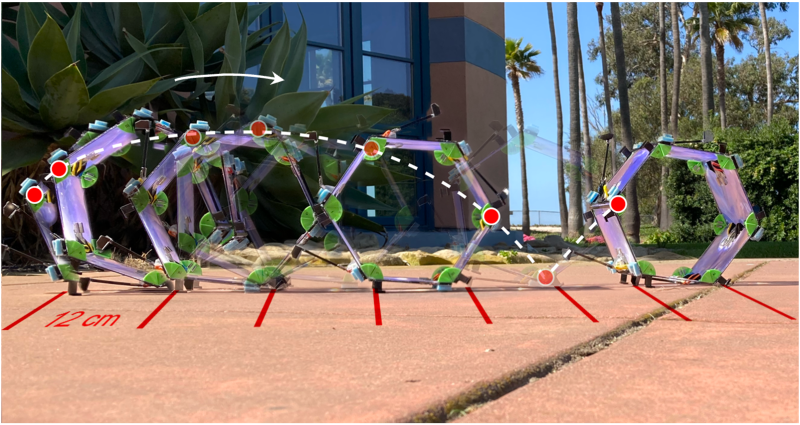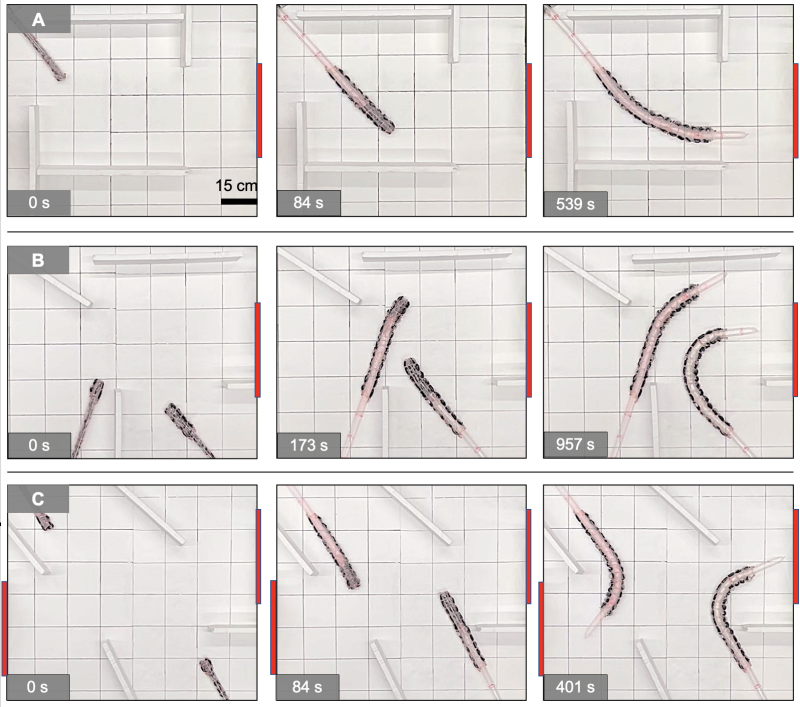Robotics gymnastics: New flexible soft robots transform health care, fabrication and materials research
Imagine a future where robots could bend, transform, change color and even adapt to their environments independently. Imagine a future where robots can not only go into spaces where humans cannot or should not but can also squeeze into the smallest of spaces, even within the human body. Imagine a future where robots could contour themselves to body parts, facilitating movement inhibited by disability. That future is here, and it is called soft robotics.
With support from the U.S. National Science Foundation, research teams across the nation have developed new approaches to soft robotics, which focus on robots that can adapt to the environment around them, giving them a greater range of movement than traditional rigid robotics. Some robots even have programmable "skins" that can change shape, color or texture when electrical impulses are applied, allowing for increased adaptability to their surroundings.
These innovations could have applications in areas from search-and-rescue missions to medicine to manufacturing and many other areas. Much of this soft robotics research has been supported through the NSF Emerging Frontiers in Research and Innovation program in the NSF Directorate for Engineering and reflects NSF’s commitment to fundamental interdisciplinary research.
"Innovations in soft robotics will allow for the fabrication of increasingly adaptable devices, which can explore spaces previously unreachable by traditional robots and create new pathways for health care delivery and diagnosis," said Sohi Rastegar, head of the NSF Office of Emerging Frontiers and Multidisciplinary Activities. "With NSF support, researchers have taken novel approaches to soft robotics that build a foundation for future innovations in this rapidly evolving field."
Adapting to changing conditions
Rebecca Kramer-Bottiglio, an engineer working in robotics at Yale University, incorporates materials science, robotics, artificial intelligence, biology and art to create shape-shifting and phase-changing materials. When integrated into robots, these materials enable transformative new capabilities via adaptive behaviors.
"Robots are traditionally mechanical assemblies designed to complete a single task in a specific context. In contrast, biological organisms adapt physiologically, behaviorally and morphologically in response to changing environmental conditions," Kramer-Bottiglio said.
Kramer-Bottiglio developed an amphibious turtle-inspired robot with limbs made with variable-stiffness materials that change between swimming flippers and load-bearing legs depending on the environment. Adapting both the form and function of the robot enabled efficient movement both in water and on land.
Kramer-Bottiglio was a 2024 recipient of NSF’s Alan T. Waterman award, the nation’s highest honor for early-career scientists and engineers.
Supporting innovation across the nation
In 2018 and 2019, NSF announced several new soft robotics awards. Some of the outcomes of those projects include:
Researchers at the Massachusetts Institute of Technology developed a thread-like, magnetically guided soft robot designed to travel through small blood vessels to assist in the remote and timely treatment of stroke patients, reducing the need for transportation to major medical centers.
A team at Cornell University has combined techniques from kirigami, the art of paper folding and cutting, and nanofabrication to develop a sub-millimeter robot fabricated with 60 individual panels connected by 200 hinges. The robot is printed in 2D but can morph into arbitrary 3D shapes and even move around. The team is working to integrate these sheets with electronic chips that would enable the robot to sense its environment and selectively activate individual hinges to facilitate the robot's response.
Soft robots can bend into an almost infinite variety of shapes, but realizing that versatility traditionally requires correspondingly large numbers of individual actuators. Researchers at the University of Tulsa are showing how incorporating patches of adjustable stiffness into the walls of a single inflatable elastic tube provides a range of shapes and poses comparable to robots built from complex and expensive arrangements of multiple inflatable chambers and valves.
Researchers at the University of California, Santa Barbara are developing soft robots based on advanced light-responsive materials. These robots use light for control, sensing and power, replacing conventional wires, circuits and motors. An especially ground-breaking concept from this project is a light-powered, tip-growing robot, which extends itself into constrained environments as much as a vine might. A prototype has been created that can respond to environmental stimuli, such as seeking light or heat sources.
Researchers at the University of Michigan are taking inspiration from the feather — one of nature's most remarkable structures. Novel feather-like sensors placed on flying doves reveal long-hidden secrets of avian flight, which are then used to improve the performance of small flying robots.
A project at Harvard University developed a lightweight, fully portable, textile-based, soft, inflatable wearable robot for shoulder assistance that provides dynamic, active support to the upper limb for people with disabilities. These devices have demonstrated immediate improvement in the active range of motion in ten individuals with amyotrophic lateral sclerosis with different degrees of neuromuscular impairment.
"Soft robots have the potential to revolutionize our lives as new modes of surgery, tools for first responders, and helpers in our homes," said Jordan Berg, a program director in the NSF Division of Civil, Mechanical and Manufacturing Innovation. "Soft robots can also be safe partners in the workplace, including standalone and wearable soft robots for manufacturing, construction and agriculture."




